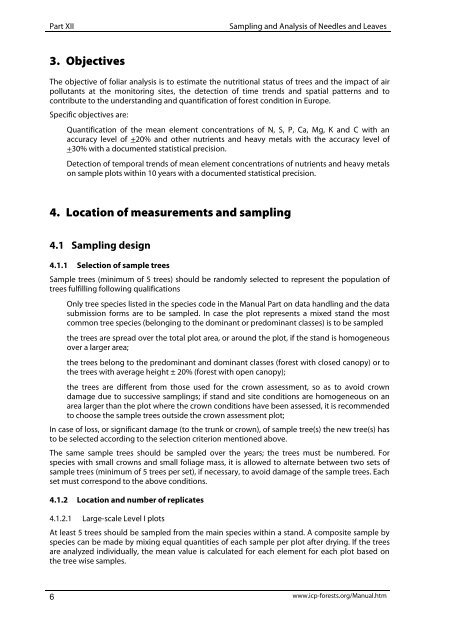Download - ICP Forests
Download - ICP Forests
Download - ICP Forests
You also want an ePaper? Increase the reach of your titles
YUMPU automatically turns print PDFs into web optimized ePapers that Google loves.
Part XII<br />
Sampling and Analysis of Needles and Leaves<br />
3. Objectives<br />
The objective of foliar analysis is to estimate the nutritional status of trees and the impact of air<br />
pollutants at the monitoring sites, the detection of time trends and spatial patterns and to<br />
contribute to the understanding and quantification of forest condition in Europe.<br />
Specific objectives are:<br />
Quantification of the mean element concentrations of N, S, P, Ca, Mg, K and C with an<br />
accuracy level of +20% and other nutrients and heavy metals with the accuracy level of<br />
+30% with a documented statistical precision.<br />
Detection of temporal trends of mean element concentrations of nutrients and heavy metals<br />
on sample plots within 10 years with a documented statistical precision.<br />
4. Location of measurements and sampling<br />
4.1 Sampling design<br />
4.1.1 Selection of sample trees<br />
Sample trees (minimum of 5 trees) should be randomly selected to represent the population of<br />
trees fulfilling following qualifications<br />
Only tree species listed in the species code in the Manual Part on data handling and the data<br />
submission forms are to be sampled. In case the plot represents a mixed stand the most<br />
common tree species (belonging to the dominant or predominant classes) is to be sampled<br />
the trees are spread over the total plot area, or around the plot, if the stand is homogeneous<br />
over a larger area;<br />
the trees belong to the predominant and dominant classes (forest with closed canopy) or to<br />
the trees with average height ± 20% (forest with open canopy);<br />
the trees are different from those used for the crown assessment, so as to avoid crown<br />
damage due to successive samplings; if stand and site conditions are homogeneous on an<br />
area larger than the plot where the crown conditions have been assessed, it is recommended<br />
to choose the sample trees outside the crown assessment plot;<br />
In case of loss, or significant damage (to the trunk or crown), of sample tree(s) the new tree(s) has<br />
to be selected according to the selection criterion mentioned above.<br />
The same sample trees should be sampled over the years; the trees must be numbered. For<br />
species with small crowns and small foliage mass, it is allowed to alternate between two sets of<br />
sample trees (minimum of 5 trees per set), if necessary, to avoid damage of the sample trees. Each<br />
set must correspond to the above conditions.<br />
4.1.2 Location and number of replicates<br />
4.1.2.1 Large-scale Level I plots<br />
At least 5 trees should be sampled from the main species within a stand. A composite sample by<br />
species can be made by mixing equal quantities of each sample per plot after drying. If the trees<br />
are analyzed individually, the mean value is calculated for each element for each plot based on<br />
the tree wise samples.<br />
6 www.icp-forests.org/Manual.htm
















